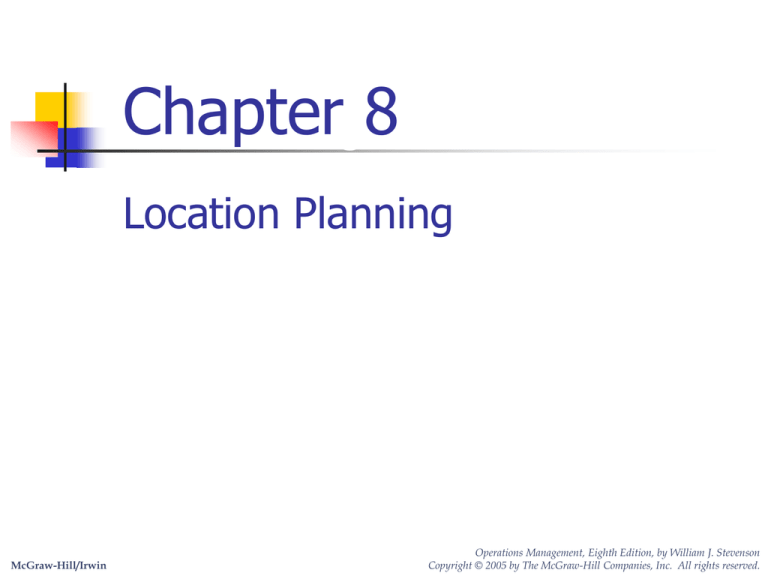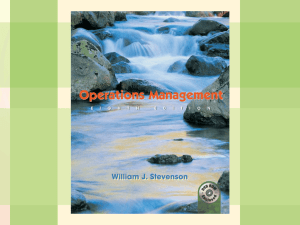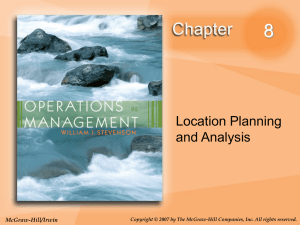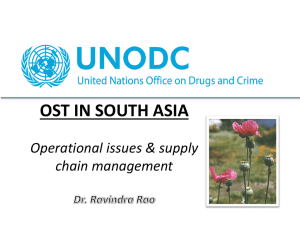
Chapter88
Location Planning
McGraw-Hill/Irwin
Operations Management, Eighth Edition, by William J. Stevenson
Copyright © 2005 by The McGraw-Hill Companies, Inc. All rights reserved.
Need for Location Decisions
Marketing Strategy
Cost of Doing Business
Growth
Depletion of Resources
Location Decisions
The importance of location
Competition
Cost
Hidden effect
Opportunity costs
Market Related Factors
Locations of demand or competition
Location Factors (General)
Tangible Cost Factors
Availability of Multiple Modes of Transportation
Labor availability and costs
Utilities
Material oriented location
Market oriented location
Energy availability and costs
Water availability and costs
Site and construction costs
Taxes
Location Factors
Intangible Factors
Zoning and legal regulations
Community Attitudes
Public opinion (noise, smoke, odor)
Expansion potential
Pollution control
Access roads and transportation facilities
Living conditions
Costs of living, housing, etc
Nature of Location Decisions
Strategic Importance
Objectives
Long term commitment/costs
Impact on investments, revenues, and operations
Supply chains
Profit potential
No single location may be better than others
Identify several locations from which to choose
Options
Expand existing facilities
Add new facilities
Move
Making Location Decisions
Decide on the criteria
Identify the important factors
Develop location alternatives
Evaluate the alternatives
Make selection
Location Decision Factors
Regional Factors
Community
Considerations
Multiple Plant
Strategies
Site-related
Factors
Regional Factors
Location of raw materials
Location of markets
Labor factors
Climate and taxes
Community Considerations
Quality of life
Services
Attitudes
Taxes
Environmental regulations
Utilities
Developer support
Site Related Factors
Land
Transportation
Environmental
Legal
Multiple Plant Strategies
Product plant strategy
Market area plant strategy
Process plant strategy
Comparison of Service and
Manufacturing Considerations
Manufacturing/Distributi
on
Service/Retail
Cost Focus
Revenue focus
Transportation modes/costs
Demographics: age,income,etc
Energy availability, costs
Population/drawing area
Labor cost/availability/skills
Competition
Building/leasing costs
Traffic volume/patterns
Customer access/parking
Trends in Locations
Foreign producers locating in U.S.
“Made in USA”
Currency fluctuations
Just-in-time manufacturing techniques
Microfactories
Information Technology
Retail Facility Location
The major criterion
used in locating a
retail facility is the
volume of demand.
Population in a given
area
Median Age
Median Income
Traffic counts at the
potential site
Public Service Facility Location
Difficulty of
measuring “socialcosts” or “social
benefits”
Average distance or
time traveled by the
users of the facility
Maximum distance or
travel time between
the facility and its
intended population
Emergency Facility Location
The objective is to
locate the facility so
that the maximum
response time to
any point of demand
is minimized.
Evaluating Locations
Transportation Model
Factor Rating
Decision based on movement costs of raw
materials or finished goods
Decision based on quantitative and
qualitative inputs
Center of Gravity Method
Decision based on minimum distribution
costs
Center of Gravity
Evaluating Locations
Cost-Profit-Volume Analysis
Determine fixed and variable costs
Plot total costs
Determine lowest total costs
Location Cost-Volume Analysis
Assumptions
Fixed costs are constant
Variable costs are linear
Output can be closely estimated
Only one product involved
Location Decisions
Example 1: Cost-Volume Analysis
Fixed and variable costs for
four potential locations
L o c a tio n
A
B
C
D
F ix e d
C ost
$ 2 5 0 ,0 0
1 0 0 ,0 0
1 5 0 ,0 0
2 0 0 ,0 0
0
0
0
0
V a r ia b le
C ost
$11
30
20
35
Example 1: Solution
Fixed
Costs
A
B
C
D
$250,000
100,000
150,000
200,000
Variable
Costs
$11(10,000)
30(10,000)
20(10,000)
35(10,000)
Total
Costs
$360,000
400,000
350,000
550,000
Example 1: Solution
$(000)
800
700
600
500
400
300
200
100
0
0
D
B
C
A
A Superior
C Superior
B Superior
2
4
6
8
10
Annual Output (000)
12
14
16












